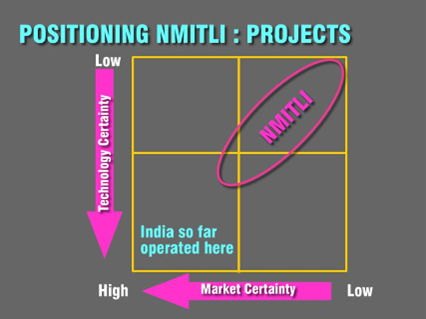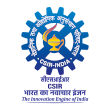Positioning of NMITLI
Positioning of NMITLI
Positioning of NMITLI
The positioning of the projects is shown in Figure below. The constant endeavor of the program is to position the projects in the upper right most quadrant where the technology and markets are less known. Consequently, the risks and rewards associated with the projects are very high. Thus the strategy adopted for NMITLI was to obtain an inverse risk-investment profile, i.e. low investment – high risk technology areas (with global leadership potential) with investments increasing as developments take place and the projects move up on the innovation curve with reduction in risks.

Monitoring and Review
For closely monitoring and reviewing the projects, a two tier system is adopted which ensures realization of the objectives and deliverables. At the first level, there is an internal Steering Committee comprising Principal Investigators (PIs), which meets once in 3 months, monitors and sets its own periodic targets to be achieved. At the second level, an external independent Monitoring Committee comprising recognized peers reviews the project once in six months and guides the project towards its final objectives. Besides reviewing the progress of the project in conformance with the objectives, the later committee is entrusted with the responsibilities to recommend: (i) foreclosure or modification of the project or sub component; (ii) inclusion of additional institutional / industrial partners wherever necessary; and (iii) revising the funding support to any / or all implementing partners.
Expanding the activities of NMITLI
As India is entering into a new era of R&D activities and innovation led development, new approaches which spur innovation and further development need to be experimented under NMITLI. Accordingly, it is proposed to expand the NMITLI program both horizontally and vertically to experiment newer ways of conducting R&D for innovation. These new approaches are described below:
1. Funding along with industry (50:50 initiatives)
There are many Indian companies who are doing financially very well but do not have the necessary expertise and intellectual resources to develop focused network projects for development of technologies/products in their line of activities. Their efforts need complementation from suitable R&D institutions and guidance from recognized peers to develop and commercialize newer technologies/products. Therefore, NMITLI proposes to leverage its experiential base to encourage and assist such companies for developing network projects for those companies in product/technology development through a specific scheme, proposed to be called as ’NMITLI 50:50 initiatives’. The projects will be developed and implemented with same rigor as that of other NMITLI projects. This initiative would be made applicable to all Indian or foreign companies having manufacturing base in India. It is envisaged to provide 50% financial support from NMITLI as grant and the rest 50% project cost would come from the company for development and commercialization of the technology/product. On successful commercialization of the technology/product, the company shall pay a commensurating royalty to CSIR.
>2. Co-financing with Venture Capital Funds
Many venture capitals are limited in scope and risk taking, due to lack of domain knowledge within the organization. Venture Capitals are therefore interested in joining hands with NMITLI, which has strong domain knowledge base, to jointly finance projects. Such projects would be identified and evolved following the procedures established by NMITLI. The funding would be joint with pre-determined ratio, but not more than 50% contribution from NMITLI. These projects are envisaged to be monitored by a joint team of experts as per the NMITLI monitoring mechanism. The proposed funding would follow the venture funding norms. The successes and failures resulting from the projects will be shared on equitable basis. This initiative would encourage venture capital funds to venture into riskier R&D areas.
3. Joint development and support of projects with other departments of science and technology and economic ministries
Many government departments particularly in economic ministries are engaged in research and development activities in areas of relevance to them. These activities often have considerable degree of overlap with other scientific departments. However, these departments’ expertise is limited to undertake multi-disciplinary projects in cutting edge areas requiring wide-spectrum of intellectual and infrastructural inputs. Such multi-disciplinary areas need expertise, inputs and concerted efforts from all concerned government departments to generate IPR, technologies and products besides high quality publications. Therefore, it is proposed to utilize part of the NMITLI funds to generate inter-departmental projects in the XI FY Plan. The proposed scheme apart from generating intellectual capital, technologies and products in cutting edge areas would act as a catalyst to bring better co-ordination among various departments of government in the R&D sphere.
4. Setting up of NMITLI Innovation Centers in selected areas for long term sustained efforts
In many areas, country has limited expertise scattered across different institutions. Such diffused expertise has not led to any worthwhile innovation in those areas. Even the networking of NMITLI would not be very effective in such cases because these areas would require long term commitment and creation of facilities at different locations. Therefore, these areas need long term sustained support with requisite human resource as well as infrastructure, assembled at one place to cross the threshold of intellectual barrier in order to generate globally competitive technologies and products, IPR, and high quality publications. It is thus proposed to set up ‘NMITLI Innovation Centres’ in PPP mode for sustained efforts in some selected areas for example, Photovoltaics, Fuel Cells, White LEDs, Industrial Enzymes, Medical Implants, Vaccine development, Seed Development etc.
These centres would be set up in an identified institution or independently. These centres will work only in the identified area. To attract and retain best talent, the scientists engaged in the activity will receive Salary plus, where salary comes from government and the plus comes from industrial partners. As suggested by EFC, such centres will be created where it utmostly required.
The financial implications for setting up each such centre will be worked out and placed before GB, CSIR for approval.
5. Support to post NMITLI projects
Despite the excellent R&D and developments, the technologies and products developed in the laboratory do not reach to the market due to lack of ‘last mile approach’. The companies need CSIR’s hand holding to develop and package the technologies/products further and commercialized it. The concept of ‘Post-NMITLI’ is being proposed to fulfill the objective of providing financial and technical assistance for pre-commercialization related activities such as scale up, pilot plants, field trials, market seeding of products, market surveys, etc. The proposed assistance in case of industry, would be in the form of soft loan. Even these Post-NMITLI projects would be monitored on the same lines as that of NMITLI vis-à-vis pre-defined objectives.
6. Acquisition of early stage relevant knowledge / IP for portfolio building
External ideas / leads / IP acquisition are assuming greater significance in the chain of innovation and mind to market. The availability of a large number of unencumbered IP (being developed in several laboratories globally) is providing a fillip to this approach. Several countries across the globe are striving to take advantage of the diversity of creativity available in different parts of world and integrate with its own developments to bring out new products / processes for global competitiveness. Since NMITLI aims to provide the Technological Leadership to the Indian industry, it becomes imperative for NMITLI to adopt such practices to achieve its objectives. As recommended by the EFC, such acquisitions shall be limited to carefully chosen areas with a view to creating a portfolio where NMITLI projects are in operation. Before acquiring IP, necessary due diligence will be carried out and the proposal will be placed to competent authority for approval.
7. Crossing the boundaries
It is increasingly being felt that to achieve leadership in niche technology areas, relying totally on internal expertise and capabilities may not be adequate. To achieve the objective of global leadership, it would be helpful to broaden the program by bringing in international expertise. The international expertise may be in the form of (i) expert advice of international experts at various stages of project development and implementation; (ii) involving international companies for product/technology development and commercialization at global scale; and (iii) engaging research institutions and/or CROs across the globe where Indian expertise need outside complementation. Thus, NMITLI seeks to draw upon or outsource the expertise, wherever it is available at a global level. The proposal would inter-alia involve relaxing the condition of Indian institutions and companies could only be partners in the NMITLI as well as releasing funds in foreign currency for drawing upon experts and expertise from abroad. As recommended by the EFC, the provision will be used selectively.
While implementing the proposal, GFR provisions, to the extent possible and feasible shall be followed. Wherever, a change is required, approval of GB, CSIR shall be obtained.
While implementing the proposal, GFR provisions, to the extent possible and feasible shall be followed. Wherever, a change is required, approval of GB, CSIR shall be obtained.
Annexure-1
Step-wise procedure for developing the Nationally Evolved Projects (NEP) under NMITLI
I. National Consultations
- Wide-spread and wide-ranging national consultations are held to identify the potential niche ideas. The consultations are usually done through letters from DG, CSIR to eminent personalities in all walks of life.
- (ii) The suggestions so received are compiled into a database.
II. Selection of suggestions / ideas
The two-tier mechanism as given below:
- A Screening Committee comprising of experts including senior officers from Government departments with wide exposure over different disciplines shortlist the suggestions / ideas for their conformance to NMITLI objectives;
- The Screening Committee’s recommendations are placed to DG, CSIR for his consideration, review and confirmation; and
- The short listed suggestions / ideas are then categorized into different areas, e.g. Agriculture, Biotechnology, Chemicals, Drugs and Pharmaceuticals, Energy, Materials, Information and Communication Technology etc.
- Separate Expert Groups are constituted by DG, CSIR to consider the short listed suggestions / ideas for selecting those of the few ideas that could provide an advantage to India. Each of the Expert Group has 4-5 experts from the relevant areas;
- The selected suggestions / ideas are then put up to DG, CSIR for his consideration, review and approval; and
- Selected ideas are then communicated to all the contributors
In addition, CSIR proactively scout for project ideas through interaction with industry and researchers. This is done by organizing interactive meetings with researchers in specific areas to catalyze potential project ideas. The selected ideas are then taken through a brainstorming meeting and the concepts are placed before DG, CSIR for his consideration and approval. These concepts are then developed into projects following the subsequent steps.
III. Preparation of Project Proposals
- For each selected idea, a Specialist Expert Group (Champions Group) is commissioned to evolve the selected idea into a project. The Group comprises of three to four experts in the relevant area with at least one of them being from industry, to provide an industrial perspective to the project. The Champions Group is provided a free hand in zeroing in on the niche segment within the selected area, developing it into a project, selecting the (best) partners, project time frame and budget estimates etc.
- Towards evolving the project, the Champions Group, besides having internal meetings among themselves, have at least one meeting with the domain specific researchers from academia, institutions & industry.
It is important to recognize that participation in NEP category of NMITLI projects is not by application, but by invitation. Further, individuals who suggested an area may or may not be part of the research project
IV. Involvement of Industrial Partners
Some of the approaches among others that are followed to enlist the industry partners are:
- Industrial partners are invited for the brainstorming meeting at the time of evolving the projects;
- Where the industry participation in the brainstorming meeting is minimal or nil, CSIR specially addresses letters to the firms in that industry sector for soliciting their interest;
- Earlier TNBD and now Mission Directorate at CSIR independently also interacts with the relevant industries and solicit their participation in the project; and
- Firms that show interest in participating in the program are enlisted in the projects.
V. Approvals
- The final project as developed is submitted for consideration of a High-Powered Committee (HPC), which is constituted by DG, CSIR. In facilitating the HPC to arrive at a decision, the Champions are invited to make a presentation to the HPC; and
- The project proposal along with HPC comments / recommendations including the funding aspect is then put up to DG, CSIR / GB(SFC) / EFC as appropriate for final consideration and approval.
VI. Disbursal of Funds
A MOU / legal agreement is entered among the partners and funds are then released to implement the project
Step-wise procedure for developing Industry Originated Projects (IOP) under NMITLI
I. Soliciting conceptual ideas/proposals
- Through press advertisement in leading national newspapers inviting conceptual proposals from Indian industry under the scheme; and
- Letters from CSIR are addressed to a large number of Indian industries inviting conceptual ideas / proposals for support under the scheme.
II. Selection of conceptual proposals
- Compilation of the conceptual ideas / proposals received within the specified time; and
- Prima facie evaluation of the conceptual ideas / proposals for their conformance to NMITLI objectives by a committee of experts drawn from different fields (set up by DG, CSIR).
- Assessment of short listed conceptual ideas / proposals by a committee of eminent technical domain experts (minimum of 3 experts) rated on 1 to 10 scale for further consideration and examination; and
- Selection of top rated one or two ideas based on average rating with a minimum rating of 5) in each broad area
III. Development of conceptual ideas into projects
Development of selected idea / conceptual proposal into project proposal with the guidance of national experts and concerned industry partner. CSIR identifies and provides these experts for helping the industry to build the proposal.
IV. Approvals
- The final project proposal as developed is submitted to the High-Powered Committee for consideration and recommendation; and
- The project proposal along with HPC recommendations is then put up to DG, CSIR/SFC(GB)/EFC, as appropriate for final consideration and approval.
V. Disbursal of Funds
An agreement is entered among the partners and then funds are released to partners for implementation of the project.

 Pensioners Corner
Pensioners Corner Screen Reader Access
Screen Reader Access Skip to main content
Skip to main content

























